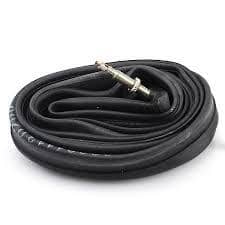[lastupdated format='F, Y']
An MTB inner tube is an inflatable tube that can be found inside the tire and makes it airtight. Although ‘tubeless’ tires are growing in popularity most bike wheels still use inner tubes.
Like a lot of the less conspicuous parts on your bike, an inner tube is one of those things you only think about when something is wrong, as in it has a puncture and you either need to patch it or replace it. Most times, if the puncture isn’t too bad you can use a puncture repair kit, but if the hole is too big or if you don’t have the time, or energy, to repair it you can buy a new one.
Purchasing a new inner tube is relatively stress-free. After all, you’re not dealing with any high tech specs, but to ensure you don’t waste time, or money, you must know what size inner and what valve type you need.
My Top #2 Mountain Bike Inner Tubes
Slime Self-Healing Smart Tubes
While it might sound like something you’d find on a kid’s game show, Slime Self-Healing Smart Tubes are rather clever ‘self-healing’ tubes that come pre-filled with sealant. It fixes punctures before you even know you have one. The sealant automatically fills the hole or puncture up to 1/8” in size. The tubes are available with Presta or Schrader valves and fit various sized tires.
Panaracer Super Tube
Panarace claims the tube is 50% thicker than the average tube, and while we’re not completely sure it’s as much as that, we’ve noticed the extra thickness helps protect the tire from flats and punctures. If you bike in areas where there are cacti and other prickly plants these tubes are perfect. The Panaracer is durable and is available in different sizes and both valve types.
Buyer’s Guide: How To Choose The Best Mountain Bike Inner Tube
Which inner tube is the right size?
Firstly, determine the size you need – this will be decided by the size of your wheels and tires. Most times there will be a series of numbers on the sidewall of the tire, this is the size of the tube you need as well. The majority of the tires will have an ISO (International Organization for Standardization) or an ETRO (European Tire and Rim Technical Organization) size along with the traditional Imperial (inches) or Metric (mm) to make finding the right size easier.
The traditional sizing will look like this ‘diameter x width’, so a mountain bike wheel (measured in inches) will be shown as 26×2.1. In this case, you will need to get a 26×1.75-2.5” inner tube.
It probably sounds more complicated than it is. In most cases, a road bike has a standard-sized tube and will have ‘road bike tube’ as part of the product description. The same goes for BMX tubes. With mountain bikes, however, there are different rim diameters, which means you will have to know if your bike has a 26”, 27.5” or 29” rims.
How To Choose The Correct Valve Type
There are two types of valves, namely Schrader and Presta. Schrader valves are also called ‘car-type’ valves because they are the exact same ones you will find on car tires. They are found on mountain bike tubes, as well as kids’ bikes, BMX’s and normal ‘commuter’ bikes. To deflate or inflate your tube using a Schrader valve, all you need to do is take off the valve cap, press the pump nozzle against the valve. The pin will depress, the valve will open and you’re good to go.
A Presta valve is found on road bikes and on some of the more expensive mountain bikes. They usually have a threaded exterior with a circular locknut, which is what keeps the valve tight and stops it from twisting off or getting damaged. The tube is easy to deflate; you simply unscrew the nut and press it into the let the air out.
What is a Dunlop Valve?
At one time the Dunlop valve, also called the Woods, was fairly popular but not so much today. It’s a variation of a pneumatic valve and looks like a cross between the Schrader and the Presta, with a collar and narrow top section, like a Presta and a wider lower section, just like the Schrader.
In Summary…
Unfortunately of all the parts on your bike, the inner tube is probably the least glamorous of them all, however, having the right one for your tire is the difference between a good day out on or bike or one spent looking for someone with a repair kit.
Save yourself the trouble and frustration and read our guide. It’s worth investing a little time beforehand, as it’ll save you a lot of trouble and frustration down the line.
As an Amazon Associate I earn from qualifying purchases. Amazon and the Amazon logo are trademarks of Amazon.com, Inc, or its affiliates.
Latest posts by Ira Ryan (see all)
- What is the Best Mountain Bike Pump? - October 31, 2023
- What is the Best Mountain Bike Multi Tool? - October 31, 2023
- How To Choose The Best Mountain Bike Inner Tubes - October 31, 2023



